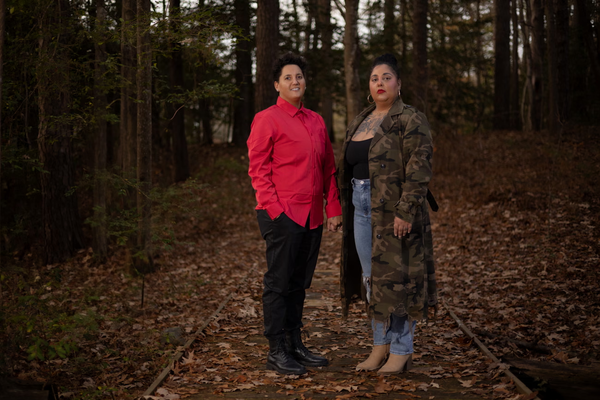A father is seen with his children three years after they vanished

From The Guardian: "A fugitive father and his three children have been spotted together for the first time in nearly three years, along the west coast of New Zealand’s North Island. Just before Christmas 2021, Tom Phillips fled into the Waikato wilderness with his children Ember, now 8, Maverick, now 9, and Jayda, now 11, following a dispute with their mother. Phillips has not been seen since last November after he allegedly stole a quad bike from a rural property and broke into a shop in Piopio. CCTV footage showed two figures on a street, believed to be him and one of the children. But a breakthrough in the search for the family came when the group was seen together last Thursday on Marokopa farmland, in New Zealand’s Waikato region, after a chance encounter with teenage pig hunters who pulled out their phones and began filming."
The enduring mystery of the Loretto Chapel's circular staircase

From Atlas Obscura: "It’s considered a miracle, an engineering marvel, and even a scientific anomaly, depending who you ask. In Santa Fe, New Mexico, the helix-shaped spiral staircase at Loretto Chapel has long puzzled visitors, including architects and physicists. There are several unknowns surrounding the staircase and its late-19th-century origins. First off: how was the 20-foot structure, which includes two 360-degree turns, built without the use of nails or other support? And how has it never wavered, despite so much use, after all these years? Also unknown is the type of wood used to build the staircase, and who built it in the first place. Neither the carpenter nor their materials have ever been identified. There are numerous conflicting theories, and roughly 250,000 visitors marvel at the chapel and its mystifyingly unsupported spirals each year."
If they hit it well, golfers here can drive a ball into another country

From Futility Closet: "Golfers at the Aroostook Valley Country Club have to play carefully — a stray shot might leave the country. The club straddles the border between the United States and Canada — the course and clubhouse are in New Brunswick, and the parking lot and pro shop are in Maine. The club was launched in 1929, when enterprising founders built the clubhouse just feet inside the Canadian border, so that visiting American golfers could evade Prohibition without having to pass through customs. Both nations still play the course today, but border restrictions imposed during the pandemic mean that Americans now have to enter at an official border crossing."
A tick is making farmers allergic to their own cows and sheep

From The Atlantic: "When Clark Giles first heard about ticks making people allergic to meat, he found the notion so unbelievable, he considered it “hogwash.” Then, in 2022, it happened to him. Following a spate of tick bites, he ate a hamburger and went into sudden anaphylaxis. His lips became numb, his face swollen, and his skin a “red carpet from my knees to my shoulders,” he says. Eventually, Giles—who raises sheep on a homestead in Oklahoma—had to give up eating not just beef but pork, and, yes, even lamb. From there, his allergy started to manifest in stranger ways. During lambing season, the smell of afterbirth left him with days of brain fog, fatigue, and joint aches. To touch his sheep, he now needs nitrile gloves. To shovel their manure, he now needs a respirator. And Giles doesn’t even have it the worst of people he knows: A friend with the same allergy was getting so sick, he had to give up his sheep altogether.
The CIA invented the lithium-iodine batteries used in pacemakers

From the CIA: "The idea surrounding the lithium-iodine battery was to create a power source that could provide a long-duration, high density energy supply in a small package. In the early 1960s, both the private and public sectors were experimenting with creating batteries using lithium as the anode material. The end result was a material that could be made into a cathode — an electrode through which electric current flows out a polarized electric device. In the early 1960s, the Agency shared the lithium-ion battery concept with the public, and a company working on an exploratory project developed and patented the first lithium-iodine battery for commercial use in 1968. Meanwhile, in Buffalo, NY, Wilson Greatbatch was working diligently to develop the first cardiac pacemaker that could safely regulate a human heartbeat. He succeeded and patented his creation in 1962, but he needed a suitable power source for his new invention."
A parasailor got footage of a dog that had climbed to the top of the Great Pyramid
Insane footage of a dog that scaled to the top of the Great Pyramid of Giza
— Science girl (@gunsnrosesgirl3) October 15, 2024
pic.twitter.com/QHKcy416Lb
Acknowledgements: I find a lot of these links myself, but I also get some from other newsletters that I rely on as "serendipity engines," such as The Morning News from Rosecrans Baldwin and Andrew Womack, Jodi Ettenberg's Curious About Everything, Dan Lewis's Now I Know, Robert Cottrell and Caroline Crampton's The Browser, Clive Thompson's Linkfest, Noah Brier and Colin Nagy's Why Is This Interesting, Maria Popova's The Marginalian, Sheehan Quirke AKA The Cultural Tutor, the Smithsonian magazine, and JSTOR Daily. If you come across something interesting that you think should be included here, please feel free to email me at mathew @ mathewingram dot com



